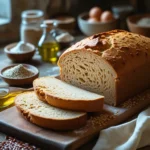How to Make the Best Gluten-Free Egg-Free Bread Recipe
A soft, flavorful gluten-free and egg-free bread made with a blend of allergy-friendly flours and natural binders. Perfect for those with dietary restrictions or vegan lifestyles.
- Prep Time: 15 minutes
- Rising Time: 1 hour 30 minutes
- Cook Time: 40 minutes
- Total Time: 2 hours 25 minutes
- Yield: 1 loaf 1x
- Category: Gluten-Free
- Method: Baking
- Cuisine: American
- Diet: Gluten Free
Ingredients
Scale
- 1 ½ cups gluten-free all-purpose flour blend (rice flour, tapioca starch, potato starch)
- ½ cup sorghum flour
- 2 tablespoons ground flaxseed (for flax egg)
- 6 tablespoons warm water (for flax egg)
- 1 tablespoon psyllium husk powder
- 2 teaspoons xanthan gum
- 1 tablespoon sugar or honey
- 1 ½ teaspoons active dry yeast
- 1 teaspoon salt
- 1 cup warm water (105°F–110°F)
- 3 tablespoons olive oil
- Optional: 1 teaspoon apple cider vinegar (helps with rise and flavor)
Instructions
- Prepare the flax egg: In a small bowl, combine ground flaxseed and 6 tablespoons warm water. Stir and let sit for 5-10 minutes until gel-like.
- Activate the yeast: In a separate bowl, mix warm water and sugar. Sprinkle yeast over the top and let it sit for 5-10 minutes until foamy.
- Mix dry ingredients: In a large bowl, whisk together gluten-free flour blend, sorghum flour, psyllium husk powder, xanthan gum, and salt.
- Combine wet ingredients: Add the flax egg, olive oil, and apple cider vinegar to the foamy yeast mixture.
- Form the dough: Pour wet ingredients into the dry ingredients and mix thoroughly with a wooden spoon or stand mixer fitted with a paddle attachment. The dough will be sticky and thick.
- First rise: Cover the bowl with a clean towel and place in a warm, draft-free area. Let the dough rise for 1 to 1.5 hours until it has roughly doubled in size.
- Prepare the pan: Grease a 9×5-inch loaf pan with olive oil or line with parchment paper.
- Transfer dough: Spoon the dough into the prepared loaf pan and smooth the top with a wet spatula.
- Second rise: Cover loosely and let the dough rise for another 30 minutes.
- Bake: Preheat the oven to 375°F (190°C). Bake the bread for 35-40 minutes until golden brown and a toothpick inserted in the center comes out clean.
- Cool: Remove the bread from the oven and let cool in the pan for 10 minutes. Then transfer to a wire rack to cool completely before slicing.
Notes
Here are some helpful notes about the gluten-free egg-free bread recipe, inspired and informed by various expert sources and tested recipes:
- Texture and Tenderness: Gluten-free egg-free bread can be soft and tender, perfect for toasting or making sandwiches. Using psyllium husk powder and xanthan gum helps mimic gluten’s elasticity and improves crumb softness.
- Rising and Baking Tips: Proper yeast activation with warm water (around 105°F–110°F) is crucial for a good rise. Allowing sufficient rising time (1 to 1.5 hours) in a warm, draft-free spot helps develop volume. Baking at 375°F for about 35-40 minutes usually yields a golden crust and fully cooked loaf.
- Binders and Egg Substitutes: Flax eggs, chia eggs, and aquafaba are excellent plant-based binders that provide moisture and structure without eggs. Psyllium husk powder is especially effective for moisture retention and chewiness.
- Flour Blends: Combining rice flour, sorghum flour, and starches like tapioca or potato starch creates a balanced texture. Some recipes also incorporate chickpea or buckwheat flour for added nutrition and flavor.
- Add-Ins and Variations: Adding seeds (pumpkin, sunflower, sesame) or nuts can enhance texture and flavor. Apple cider vinegar can improve rise and add subtle tang.
- Cooling and Slicing: Letting the bread cool completely before slicing is important to avoid gummy or squished slices, a common issue with gluten-free breads.
- Storage: Store bread at room temperature in an airtight container for up to 2 days or freeze sliced portions for longer storage (up to 3 months).
- Equipment: A stand mixer with a paddle attachment can simplify mixing sticky gluten-free doughs, but hand mixing works too.
- Dietary Notes: This bread is suitable for vegans and those with egg and gluten allergies. It can be made dairy-free by using plant-based oils and milk substitutes if desired.
These notes should help you understand the recipe’s characteristics and how to achieve the best results when baking gluten-free egg-free bread.
Nutrition
- Serving Size: 1
- Calories: 110 kcal
- Sugar: 2g
- Sodium: 180mg
- Fat: 3.5g
- Carbohydrates: 22g
- Fiber: 3g
- Protein: 3g
Keywords: Gluten-Free Egg-Free Bread Recipe
